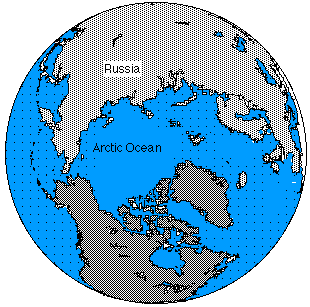|
|
 |
|
|
|
United States |
|
|
|
|
|
The end of the Cold War seemed to have transformed this area from a military frontier to an area of potential co-operation. The Inuit peoples (Eskimos) inhabit many of the areas in this map, especially Greenland, northern Canada, Alaska and parts of Siberia in the former Soviet Union. As the defense installations are run down, oil exploration, especially in Siberia, is increasing. The Arctic Ocean is likely to become a trade route between
Europe and east Asia, and is already an important air corridor.
There are proposals to build cargo carrying submarines which
could use the route even when the ocean is frozen. A Circum-Polar Conference has been held which may evolve into the political instrument of Arctic management linking Canada, Russia, Alaska, Greenland and the Scandinavian states, but this is rather optimistic, considering the rivalry developing over oil and trade routes.
Global warming is lengthening the period of open water in the ocean. Already the ice is reported to be much thinner than in the past. In 2007 the Northwest Passage - a potential shipping lane between Europe and China - was free of ice for the first time in recorded history. There are now disputes between Russia, the United States and Canada about who controls these waters. The NWP passes between islands claimed by Canada, which is planning to build bases in the area and to deploy ships. Russia has claimed much of the Arctic Ocean by following the undersea Lomonosov Ridge. The US claims the waters are International. Denmark, through Greenland is also interested in claiming sovereignty of the waters and subsea near Greenland. Presumably it is the hope of finding oil that causes all this activity. China is interested in the NWP trade route. Soviet dumping of nuclear materials in the Arctic Ocean is a serious problem, affecting the whole oceanic area. The Inuit are finding it harder to hunt and fish at the traditional times because of the retreat of the ice. Even more affected are the Polar Bears which cannot hunt when the ice has gone. They are threatened with extinction as Global Warming proceeds. (Perhaps some will need to be taken to an Antarctic refuge to save them for the distant future when the ice returns.) There is a dispute between the US and Canada over the sovereignty of the sea route between the Atlantic and the Pacific. Canada claims sovereignty over the area formerly covered by permanent ice; the US claims it is International Waters. In 2007 Russia has laid claim to a large area of Arctic Ocean, based on a sub-sea mountain range claimed to be part of Russia's Continental Shelf. It is presumed this is a preliminary to exploration for oil and gas. Paradoxically, the opening up of the Ocean by Global Warming has made exploration for fossil fuels easier. Russia's activities seem to be making the Arctic once again a zone of military competition. This article is about that. Canada has a port at Churchill on Hudson's Bay, linked by rail to central Canada. This is being developed as a possible route for imports and exports. |
Interesting
reading Laurence Smith - The New North The New North: The World in 2050 New North |
|
Europe |
Americas |
World Info |
Home |
